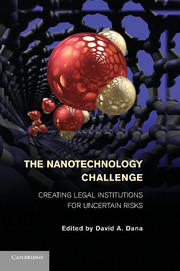Book contents
- Frontmatter
- Contents
- Contributors
- Part I Introduction
- Part II Public Perceptions of Nanotechnology Risks
- Part III Meeting the Nanotechnology Challenge by Creating New Legal Institutions
- Part IV Where We Are Now – The Current Framework for Nanotechnology Regulation
- 14 An Overview of the Law of Nanotechnology
- 15 Regulatory Responses to Nanotechnology Uncertainties
- Index
- References
14 - An Overview of the Law of Nanotechnology
Published online by Cambridge University Press: 05 December 2011
- Frontmatter
- Contents
- Contributors
- Part I Introduction
- Part II Public Perceptions of Nanotechnology Risks
- Part III Meeting the Nanotechnology Challenge by Creating New Legal Institutions
- Part IV Where We Are Now – The Current Framework for Nanotechnology Regulation
- 14 An Overview of the Law of Nanotechnology
- 15 Regulatory Responses to Nanotechnology Uncertainties
- Index
- References
Summary
Introduction
With the growing prevalence of nano-enabled materials reaching the marketplace in new products, the perceived need for regulation of such materials has correspondingly increased. There is significant debate, however, regarding the extent to which the government should regulate nanotechnology or nanotechnology-based products, and this uncertainty is reflected in the lack of comprehensive oversight of both the development and the sale of nano-enabled products and technologies. In the United States, regulatory agencies at both the state and national level have struggled to keep pace with the exploding market for nano-enabled products, from electronics to cosmetics, food, and other industrial uses. The European Union, on the other hand, has attempted to lead the way with a precautionary approach to nanotechnology in the marketplace. This chapter provides a general overview of current and proposed nanotechnology regulations, in both the United States and the European Union.
Environmental Protection Agency
Although there is no uniform and comprehensive regulation of nanomaterials in the United States, the U.S. Environmental Protection Agency (EPA) regulates nanomaterials in several ways: through the reporting requirements of the Nanoscale Materials Stewardship Program; through the Green Chemistry Initiative; through the complex regulatory scheme established by the Toxic Substances Control Act; and through potential new interpretations of the Federal Insecticide, Fungicide, and Rodenticide Act.
- Type
- Chapter
- Information
- The Nanotechnology ChallengeCreating Legal Institutions for Uncertain Risks, pp. 357 - 378Publisher: Cambridge University PressPrint publication year: 2011



